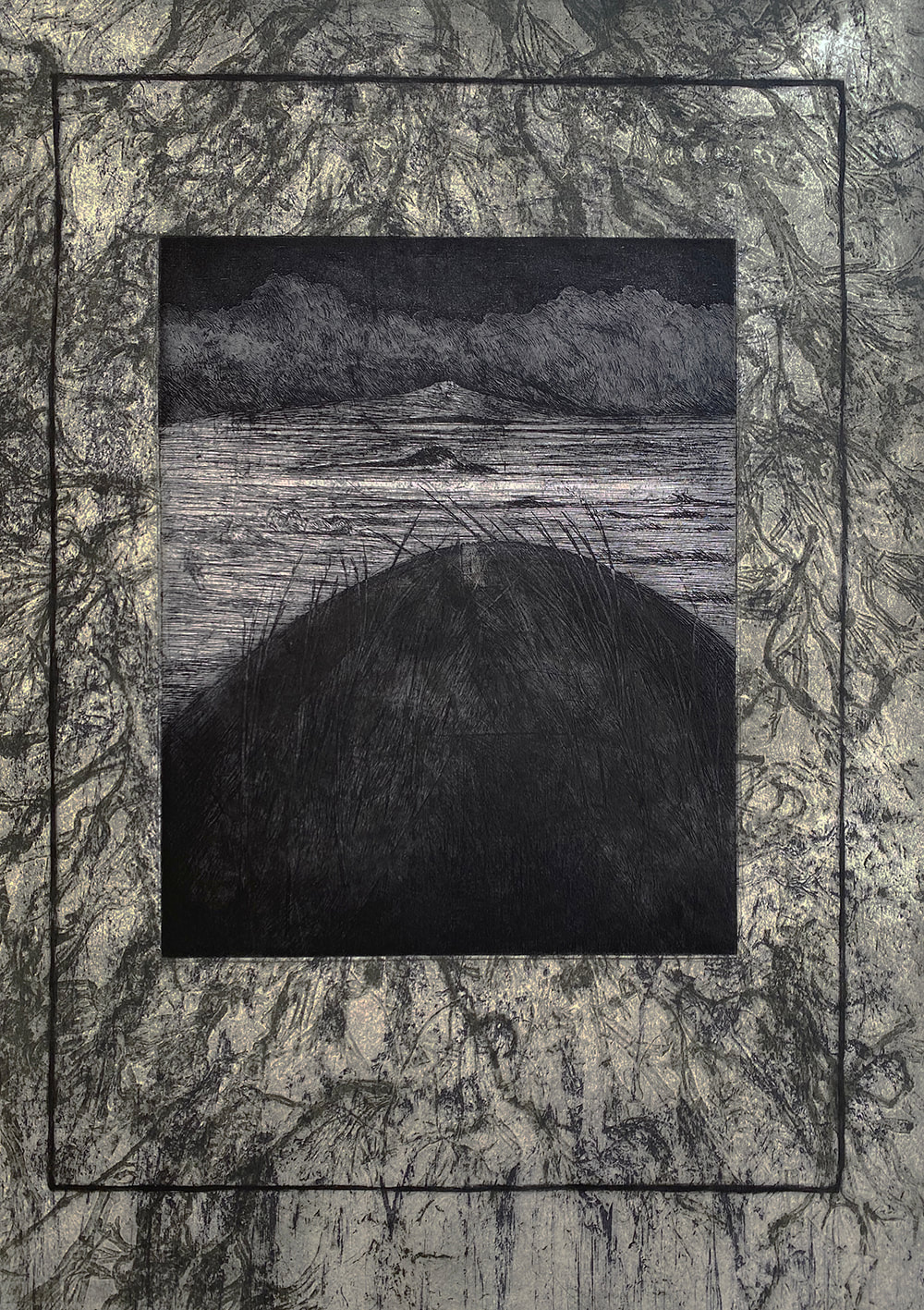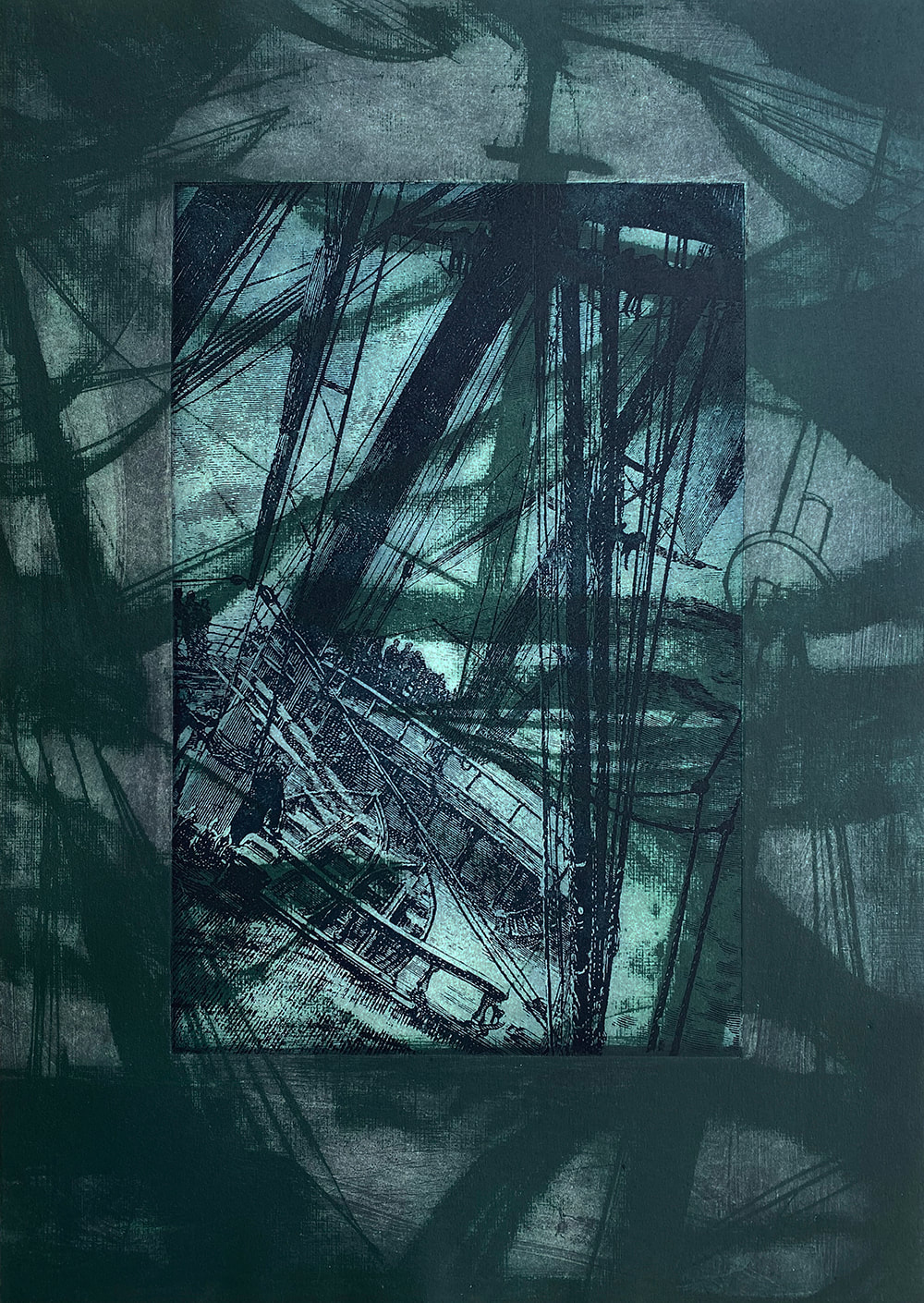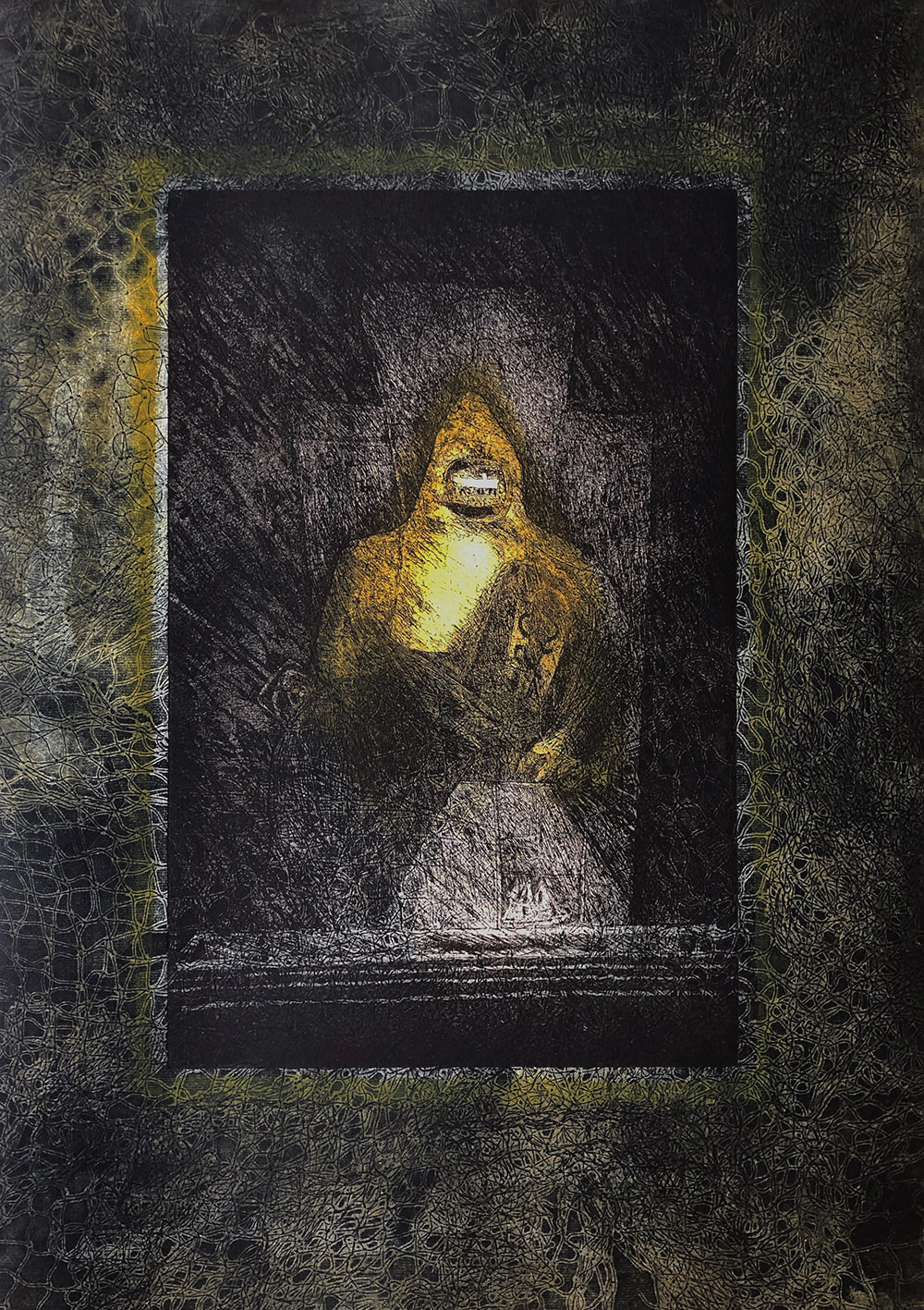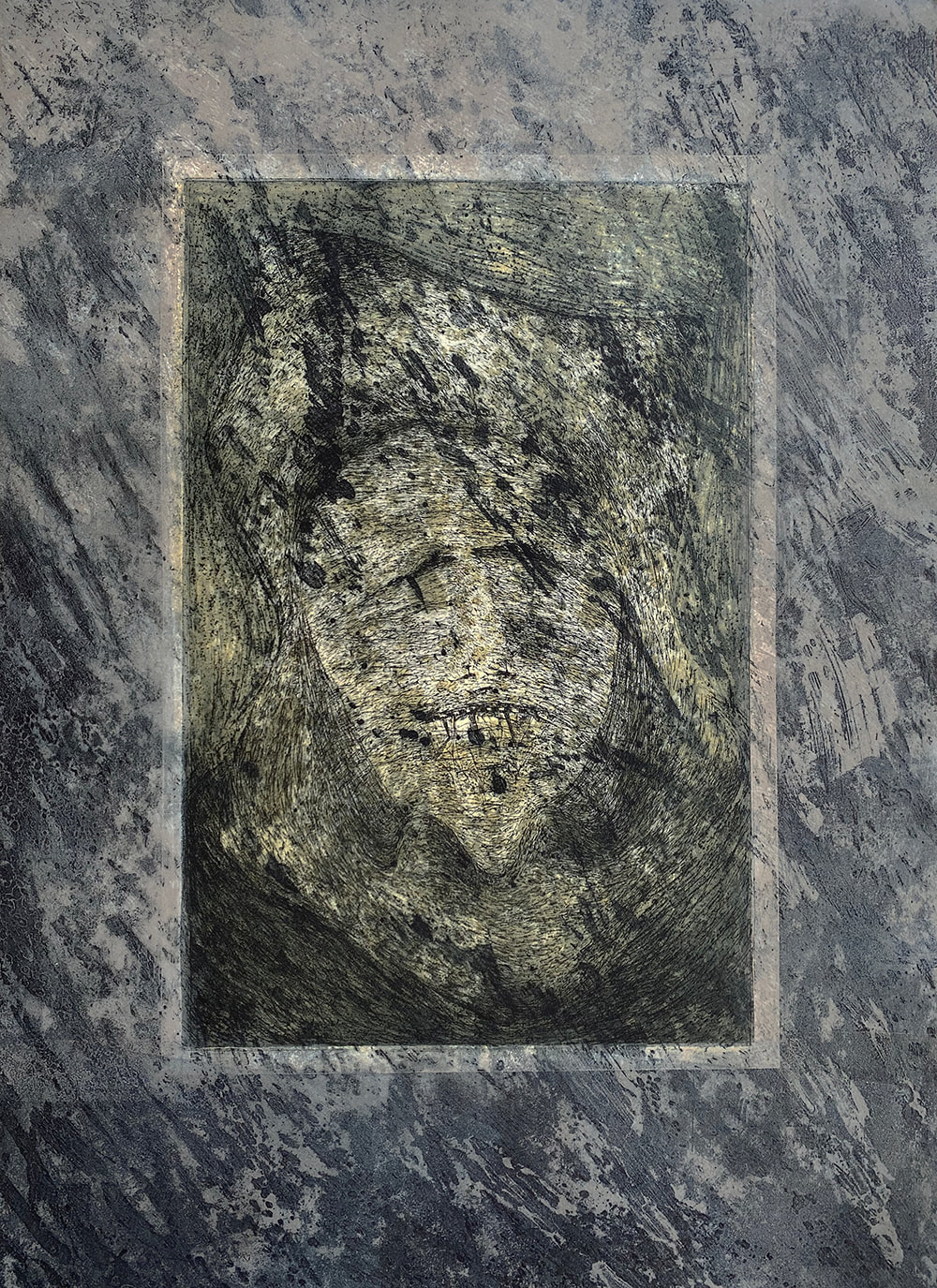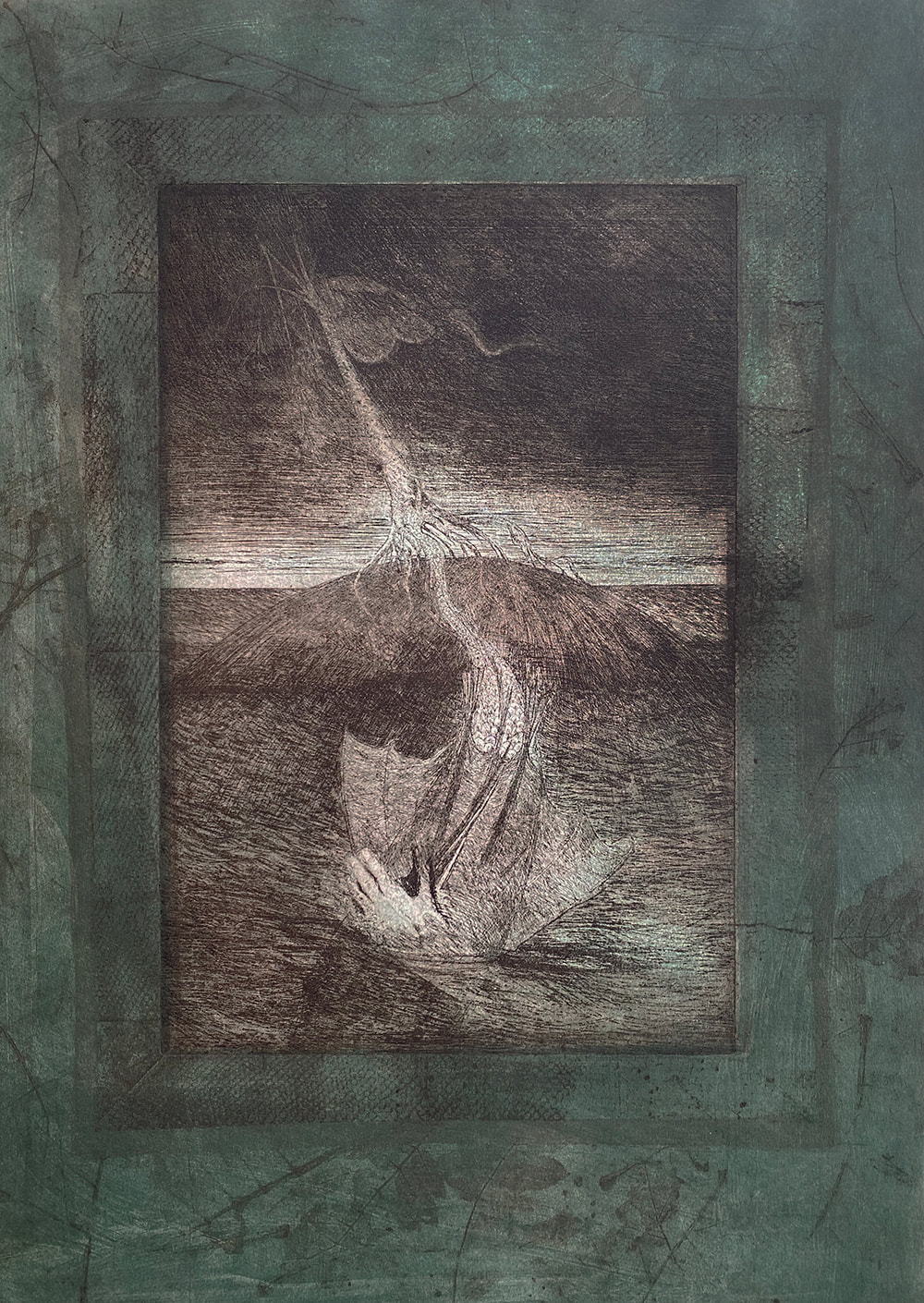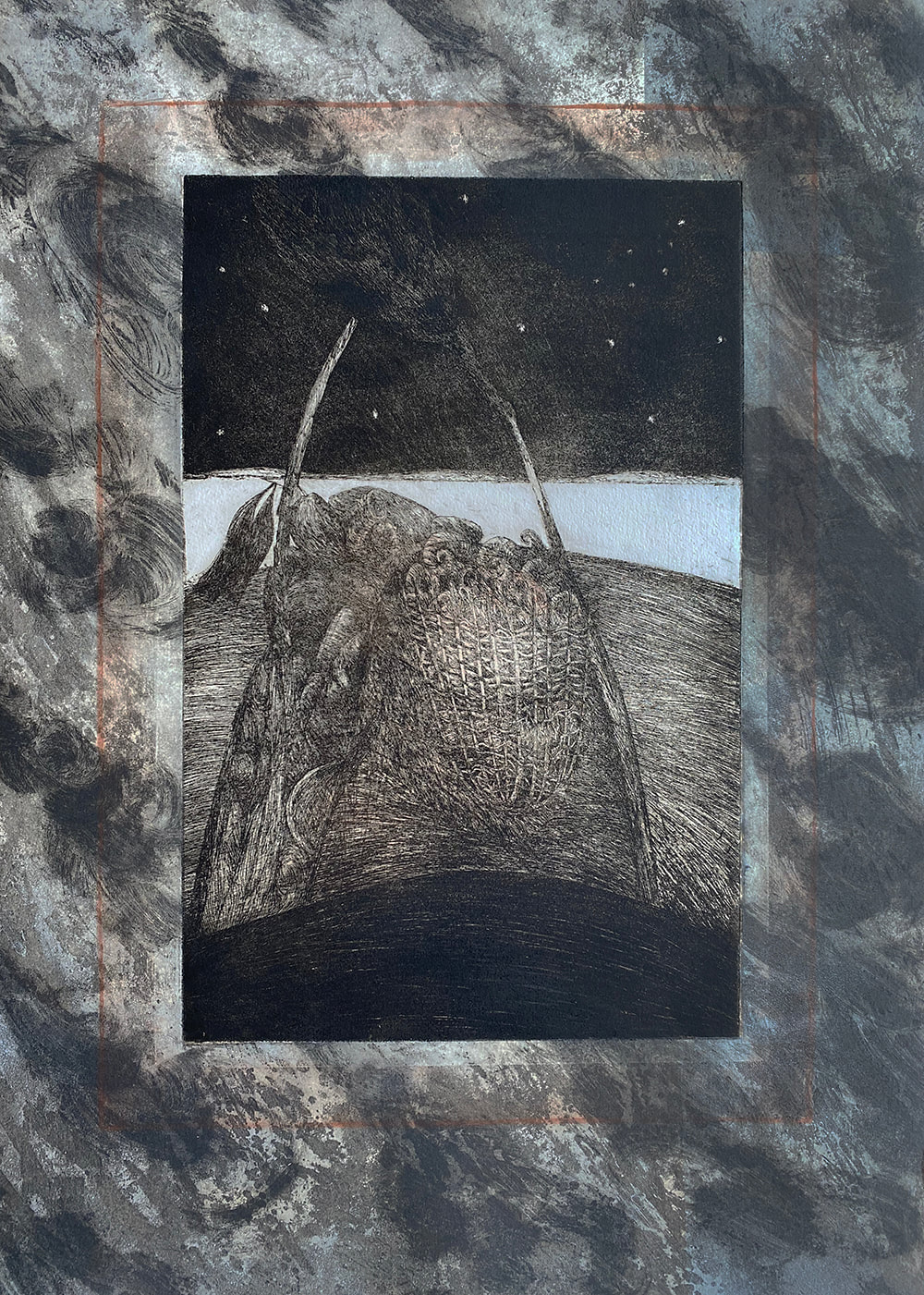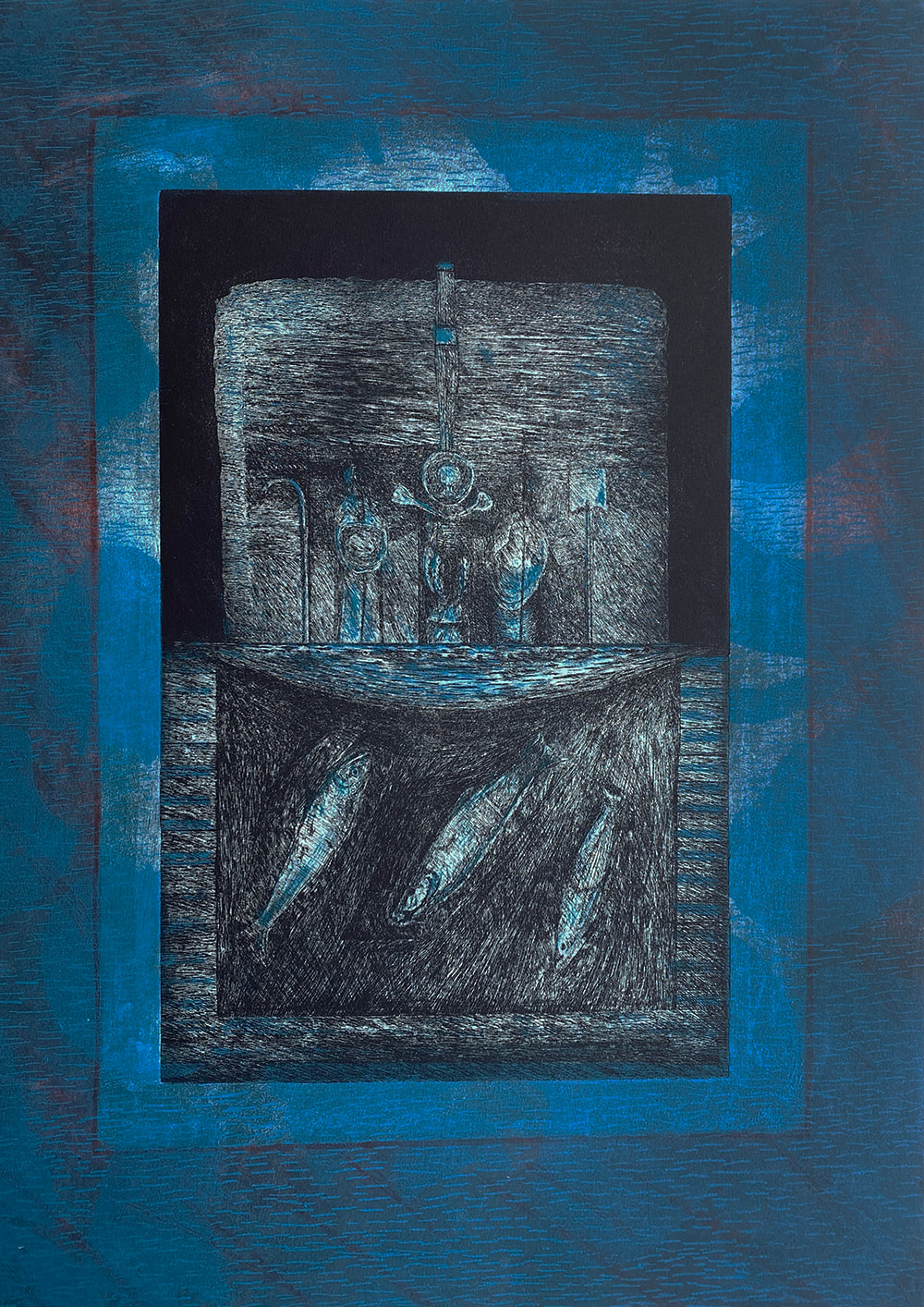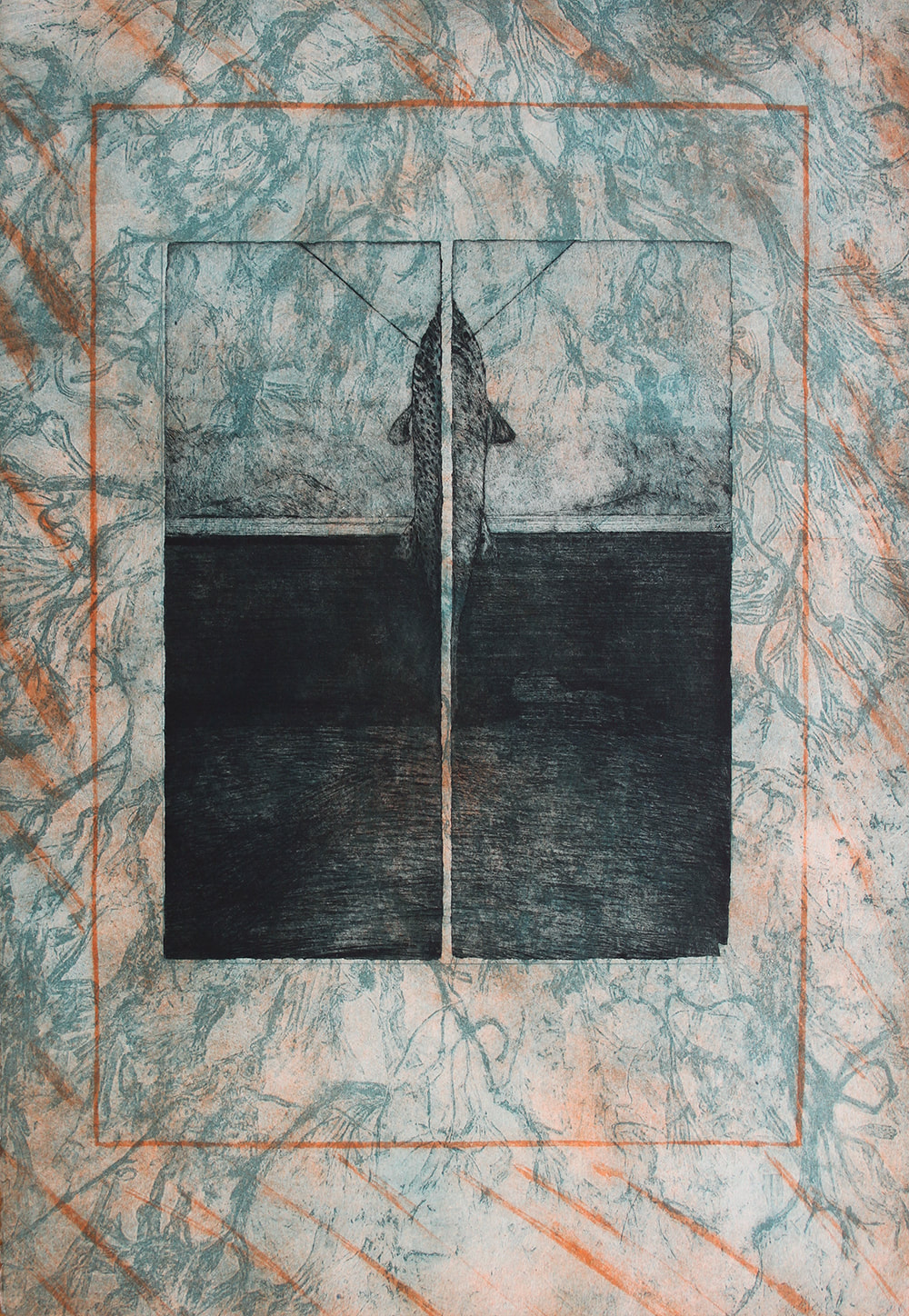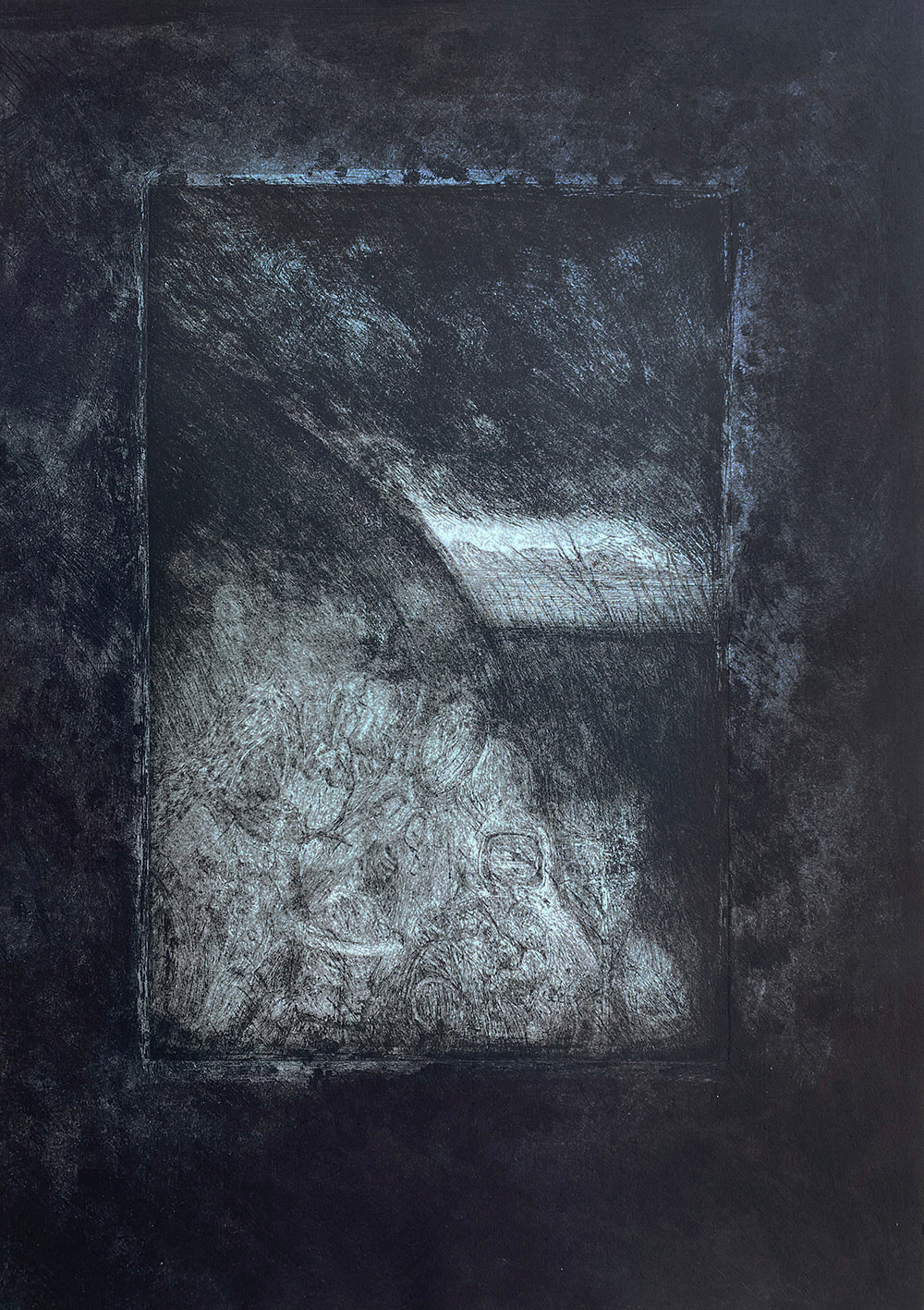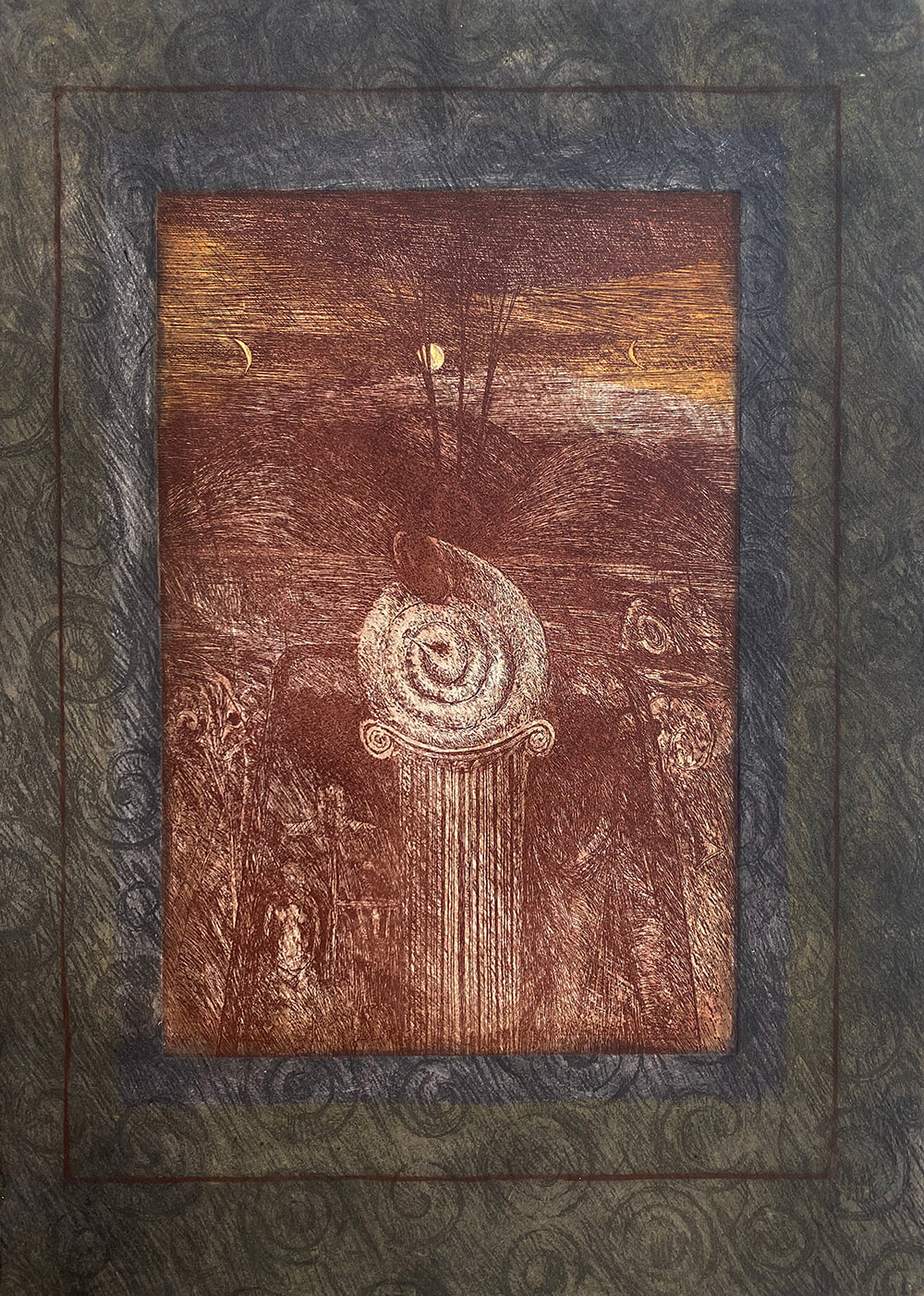Viewing Room
Welcome to the Castle Gallery Viewing Rooms where you will find highlights from selected artists focussing on key works, inspirational ideas and telling the stories behind the show. Best viewed on a desktop browser.
WILL MACLEAN
‘A Night of Islands’
Ten etchings inspired by poems and prose in Gaelic and English. An edition of 40 sets, plus artist’s proofs, each measuring 75 x 53.5cm. Each print is signed by the artist on the reverse. Published in 1991 by The Paragon Press, London and printed by Peacock Printmakers, Aberdeen.
Ten etchings inspired by poems and prose in Gaelic and English. An edition of 40 sets, plus artist’s proofs, each measuring 75 x 53.5cm. Each print is signed by the artist on the reverse. Published in 1991 by The Paragon Press, London and printed by Peacock Printmakers, Aberdeen.
The Royal Scottish Academy and the University of St. Andrews both own a set of these prints which is an indication of their significance in contemporary Scottish art. David Patterson in his foreword to the book ‘Will Maclean: Points of Departure’, remarks on this series of handmade etchings “These prints, each inspired by Gaelic poetry or prose, are full of imagery that touches upon Scottish history and folklore. They are exquisitely printed – some pale and delicate, others dark and brooding. I still regard them as one of the finest suites of prints by a Scottish artist.”
This imagery is Will MacLean’s artistic response to his interest in and concern for the dying culture of the Gael. Folklore, mythology, oral history and poetry from the Gaidhealtachd informs this work as does his own Highland background and time at sea. The portfolio title ‘A Night of Islands’ conjures an image of Will Maclean sailing the waters of the Hebrides on a moonlit night absorbing all the stories and histories of the people and places that he passes. This series of original etchings is playing its part in helping to keep that culture alive.
This imagery is Will MacLean’s artistic response to his interest in and concern for the dying culture of the Gael. Folklore, mythology, oral history and poetry from the Gaidhealtachd informs this work as does his own Highland background and time at sea. The portfolio title ‘A Night of Islands’ conjures an image of Will Maclean sailing the waters of the Hebrides on a moonlit night absorbing all the stories and histories of the people and places that he passes. This series of original etchings is playing its part in helping to keep that culture alive.
|
A Highland Woman
Inspired by a poem by Sorley Maclean in which he conjures a desolate image of a Highland woman whose ‘black labour’ in life is finally ended by the release of death. Will Maclean’s black etching shows the woman’s head, her landscape and her gravestone with a border of seaweed to represent her wasted hours gathering kelp.
Hast Thou seen her, great Jew,
who art called the One Son of God? Hast Thou seen on Thy way the like of her labouring in the distant vineyard? The load of fruits on her back, a bitter sweat on brow and cheek, and the clay basin heavy on the back of her bent poor wretched head. Thou hast not seen her, Son of the carpenter, who art called the King of Glory, among the rugged western shores in the sweat of her food's creel. This Spring and last Spring and every twenty Springs from the beginning, she has carried the cold seaweed for her children's food and the castle's reward. And every twenty Autumns gone she has lost the golden summer of her bloom, and the Black Labour has ploughed the furrow cross the white smoothness of her forehead. And Thy gentle church has spoken about the lost state of her miserable soul, and the unremitting toil has lowered her body to a black peace in a grave. And her time has gone like a black sludge seeping through the thatch of a poor dwelling: the hard Black Labour was her inheritance; grey is her sleep to-night. |
|
Adam's Clan
Inspired by ‘Clann Àdhaimh’ a haunting poem on the condition of humanity by Deòrsa Mac Iain Dheòrsa (George Campbell Hay) written c.1945. In the etching Maclean gives us a glimpse of the boat tossed about on the seas, as if through the veil of rigging, flapping sails and sea spray. This ship is a metaphor for the Gaelic language and culture.
Maclean’s extensive knowledge of rigging and the sea is conveyed through the superb draughtsmanship of this image and relates back to his time at sea as a merchant sailor and fisherman. Siud bàrca beag le antrom gaoithe sìorraidh
’na siùil chaithe, a’dìreadh cuain gun chòrsa, ’s I leatha fhèin an cearcall cian na fàire, is gul is gàireachdaich triomh chèil’ air bòrd dhith. Tha Bròn, Aoibh, Aois is Òige, Sàr is Suarach a’ tarraing nam ball buan a tha ri ‘brèidibh; tha Amaideas is Gliocas, Naomh is Peacach air a stiùir mu seach is càch gan èisteachd. Fo speur tha uair grianach, uair sgreunach, -clais is cìrein – fèath is doineann – thèid i, gu fàire nach do leum saidh riamh no sùilean, ’s a lorg ’s a h-ùpraid ghuth ’dol bàs ’na dèidh-se. Ceangal Siud i is brù air a siùil ’s i ‘deuchainn gach sgòid, long àrsaidh le sunnd is sùrd is lèireadh air bòrd; fàire làn rùn nach do rùisgeadh fo cheann a croinn speòid, is cop uisge a stiùrach a’ dùnadh ’ga chall sa mhuir mhòir. Yonder sails a little bark, with the grievous burden of an eternal wind on her worn sails, climbing and ocean that has no coast, alone within the distant circle of the horizon, with a confusion of weeping and laughter aboard her. Grief, Joy, Age and Youth, Eminent and Of-No-Account are heaving at the everlasting gear that trims her canvas; Folly and Wisdom, Saint and Sinner take her helm in turn, and all obey them. Under a sky now sunny, now lowering -trough and crest- calm and tempest- she goes on to a horizon that neither stem nor eye yet overleapt, and her track and her tumult of voices die astern of her. Envoi There she goes with a curve on her sails, putting each sheet to the test, an ancient ship with bustle and cheer and suffering aboard her, a horizon full of secrets unrevealed under her bowsprit head, and the foam of her wake closing and losing itself in the great sea astern. |
|
Dancers
Inspired by a poem by Angus Martin which was dedicated to Will Maclean. Both Martin and Maclean came from a maritime background and had spent time at sea and had experienced the end of the old ways before the advances of rampant technology destroyed the herring-fishing. Angus Martin and Will Maclean collaborated on a project to document the demise of ring-net fishing on the West Coast of Scotland. For the ‘Ring Net Project’ of 1973 Maclean completed more than 400 drawings documenting ring-net herring fishing (now in the permanent collection of the National Gallery of Modern Art, Edinburgh).
The etching refers back to a painting, ‘Skye Fisherman: In Memoriam’ from 1989 which honours William Reid, the artist’s uncle, who was a ring-net fisherman. The border is created from imprints of nets. The bright halo of oilskin shines out from the dark night and is framed by the suggestion of a boat cabin. And I wished that I could dance
in a yellow oilskin suit, dance on the dancing water to the slap of an old thigh boot. They were the champions of some greater dance performed in a night of islands. |
|
Elegy to Captain Ferguson
Captain Ferguson was a notorious Hanovarian naval officer, originally from Scotland, who brutally supressed the Highland people after the Battle of Culloden in 1746. The poem in Gaelic ‘Marbhrann do Chaiptean Fearghuston’ by Iain Mac Fhearchair (John MacCodrum), an eighteenth-century bard from Uist, tells of the rumour of the death of Captain Ferguson by drowning, which unfortunately proved to be false. Will Maclean’s etching shows the five mountains which narrate the poem and the face of the drowned Ferguson with an upturned ship as his mouth.
|
|
Fraoch
Inspired by a traditional Gaelic poem from the sixteenth century found in the ‘Book of the Dean of Lismore’ in which Fraoch is sent to retrieve a branch from a magical rowan tree. Fraoch swims to an isolated island guarded by a sea monster but when he uproots the rowan tree the monster awakes and tears off Fraoch’s arm, he is mortally wounded and eventually dies in the arms of his lover, Findabair. The border is created from imprints of rowan leaves and an old snakeskin handbag to suggest the scales of the monster.
|
|
Strathnaver
Inspired by a poem ‘Srath Nabhair’ by Ruairidh MacThomais (Derick Thompson) 1921-2012 from ‘Creachadh na Clarsaich/ Plundering the Harp’ (Macdonald, 1982). Strathnaver in Sutherland is infamous for the brutal clearing of the crofting people from their land by Patrick Sellar, factor for the Duke of Sutherland in the early nineteenth century. In the etching smoke rises from the timbers of their burning homes leaving only the stars for shelter as the sinister creel of sheep horns takes centre stage.
Anns an adhar dhubh-ghorm ud,
à irde na sìorraidheachd os ar cionn, bha rionnag a’priobadh ruinn ’ s I freagairt mireadh an teine ann an cabair taigh m’ athar a’ bhlianna thugh sinn an taigh le bleideagan sneachda. Agus siud a’ bhlianna cuideachd a shlaod iad a’ chailleach don t-sitig, a shealltainn cho eòlach ’s a bha iad air an Fhirinn, oir bha nid aig eunlaith an adhair (agus cròthan aig na caoriach) ged nach robh àit aice-se anns an cuireadh i a ceann fòidhpe. A Shrath Nabhair ‘s a Shrath Chill Donnain, is beag an t-iongnadh ged a chinneadh am fraoch àlainn oirbh, a’ falach nan lotan a dh’fhàg Pàdraig Sellar ‘s a sheòrsa, mar a chunniac mi uair is uair boireannach cràbhaidh a dh’ fhiosraich dòrainn an t-saoghail-sa is sìth Dhè ’na sùilean. In that blue-black sky, as high above us as eternity, a star was winking at us, answering the leaping flames of fire in the rafters of my father’s house, that year we thatched the house with snowflakes. And that too was the year they hauled the old woman out on to the dung-heap, to demonstrate how knowledgeable they were in Scripture, for the birds of the air had nests (and the sheep had folds) though she had no place in which to lay down her head O Strathnaver and Strath of Kildonan, it is little wonder that the heather should bloom on your slopes, hiding the wounds that Patrick Sellar, and such as he, made, just as time and time again I have seen a pious woman who has suffered the sorrow of this world, with the peace of God shining from her eyes. |
|
The Author of this is Bard MacIntyre
This etching is inspired by a poem ‘The Ship of Woman’ by Bard Macintyre from the sixteenth century ‘Book of the Dean of Lismore’. This is a ship of folklore and tradition, and it carries a cargo of three strange and evil women who seem to be portents of fate, whilst ominously large fish swim below. This etching refers back to ‘Bard McIntyre’s box’ of 1984 which is owned by the Scottish Gallery of Modern Art.
What is this ship on Loch Inch,
Of which we now may speak? What brought this ship on the loch, Which songs cannot o'erlook? I would like much to ask, Who was it brought that ship, Afloat upon that angry loch, Where changes often come? The fierce wind from the hills, And bitter storms from the glens, Oft has the vessel from the shore, Stolen upon the dangerous sea. Stranger, who sawest the ship, On the rough and angry stream, What should hinder thee to tell About her and about her crew? An old ship without iron or stern, Never have we seen her like, The vessel all with leather patched, Not even beneath the waves is't tight. Her boards are trifling bits of deals, Black patches down along her sides, Useless nails to fix them on Upon her scanty, stinted ribs. What woman cargo is in the black ship Pulling her on betwixt the waves, The cargo heartless and senseless too? Widows of a foolish mind, A boasting, talkative crew, A load vexatious and bad, Quarrelsome and covetous, Of evil minds and evil deeds. Their ways and conversation bad, A band of well-known fame, No substance in what they say, Drunken, singing, with levity, A band ill-shapen, mischievous, Who live by both sides of Loch Inch. In spite of thee and of their ship On the stormy sea's dun face, No good woman could take that ship, However pressing the constraint. The worst of women go to sea, Others cannot give them help. Let this ship be driven from the loch, Down to the fierce and roaring deep, Let the wind pursue the ship, To the old point of Seananach. There will I leave upon the stream, The ill-favoured, ill- doing ship, Of wicked widows full on the sea, Without a psalm or creed e'er said, What. |
|
The King's Fish
This etching is inspired by a traditional Gaelic poem ‘Iasg an Righ’ which tells of a fishing trip in which both the Viking and Irish king hook the same dogfish at the same time and so quarrel over ownership of the fish – possibly a metaphor for the battles for ownership of the Western Isles, the Isle of Man and Ireland. Will Maclean has cleaved the etching plate in two to symbolise the acrimony. Seaweed has been imprinted into the border to extend the marine theme.
|
|
The Loss of Gaelic
‘Sioldadh no Gaidhlige’, a poem by Meg Bateman, was the inspiration for this etching. The poem deals with the decline of the language and culture of the Gael with the imagery of a fraying anchor rope. Will Maclean’s dark mournful etching, with half-present figures and obscured symbols conveys this dreadful loss. However, there is a glimmer of hope on the horizon as a shaft of light illuminates the Highland landscape. ‘Sioldadh no Gaidhlige’, translated into ‘The Loss of Gaelic’ by Meg Bateman.
You gave me an intellectual grasp
of something unique dying out, of a despoiling humanity for which there can be no reparation… An old woman dies at home, your anchorage rope is fraying; now I can see in your eyes the heart-break of the matter. |
|
Trio
The number three holds magical or mystical associations in many cultures and this is explored in the poem by Edinburgh based contemporary poet, Valerie Gillies. The poem tells of the continuum of the cycle of life and in the etching this is made visual with the never-ending phases of the moon and the spiral shell presented on an altar-like plinth. The image has a spiritual quality to it, reflecting on the mystery of the unknown forces of nature.
|
Will Maclean is one of the outstanding Scottish artists of this generation. He is Emeritus Professor at Duncan of Jordanstone College of Art, a fellow of both the Royal Scottish Academy (RSA) and the Royal Society of Edinburgh (FRSE), he received an MBE for services to higher education and art in 2006 and is featured in The Tate’s ‘Artists’ Lives’ oral history archive. The Castle Gallery in Inverness is very lucky and privileged to be able to offer for sale several original, hand-made prints and a few paintings by Will Maclean.
